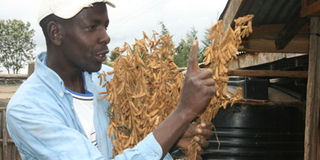AP officer arrests poverty with soya beans venture

Administration Police officer Kennedy Kitur makes a point during interview with ‘Seeds of Gold’ at his farm in Sachangwan. PHOTO | CAROLINE CHEBET
What you need to know:
- Experts say that farming soya beans does not only have economic benefits but also is a booster to soil health as it has a lot of leaves which drop to the land when it matures and dries up.
- Growing soya beans is suitable for areas that are at an altitude of between 1,000 and 1,500 above sea level. These areas, according to Ndehero, are lowlands and lower highlands.
Farms around Sachang’wan area of Molo sub-county are characterised by withered maize stalks.
From a distance, one would mistake the withering to some ready-to-harvest, healthy maize.
Such a person would be forgiven for thinking that maize farmers around this area will soon be smiling all the way to the bank.
But no. Most maize farms here, like in other areas of the larger Rift Valley, were badly affected by Maize Lethal Necrosis Disease (MLND)— a viral disease that has in recent years pushed many a farmer in Kenya’s bread basket to poverty.
Yet as his neighbours gnash their teeth, Kennedy Kitur is a happy man. The Administration Police officer does not regret his decision to try a hand in Soya beans farming on his half-acre piece of land.
This, he said, was triggered by two things: First, he witnessed how the same disease had affected other farmers in Bomet at a time he had gone visiting a relative a year ago.
He had also been disappointed by poultry farming. He had bought 350 chicks and had hoped to collect over 300 eggs a day. However, the layers only gave him eggs for two months. Not even the intervention from the local veterinaries could save Kitur’s poultry farming.
“The brooding company only refunded me the Sh30,000 I had spent on chicks and warned me against spreading stories on my fate as their client,” said Kitur.
SOUGHT ADVICE
That, coupled with fear of losing his maize crop, drove the father of four to Egerton University’s horticultural department where he sought advice on which other farming he would venture into.
He was advised to grow soya beans and was referred to Kenya Agricultural and Livestock Research Organisation (KALRO), formerly Kari.
It was here that Kitur bought 10 kilogrammes of soya beans seed at Sh1, 500.
He further got two students from Egerton University who would spend three months on attachment at his farm tending to the new crop.
“The students got a chance to practice what they learnt in school while they taught me about soya farming,” said Kitur.
The university will for the next three years be posting students from the horticulture depart on his farm.
And Kitur is already reaping the fruits of his diversification. The soya beans, which he harvested recently, are on high demand.
“A cooking oil manufacturing company and an animal-feeds producing one have been asking me to sell my produce to them but I am unsure whom to sell to,” said Kitur
He expects to collect approximately 300 kilogrammes of soya beans after he is through with threshing. He says he won’t sell it at anything less than Sh150 per kilo.
“Unlike maize where I have millers as the only potential clientele, I can sell my soya beans to many categories of clients,” said Kitur. Soya beans take four months to mature and require weeding twice.
NEED TO EXPAND
Motivated by his expectation to earn more, Kitur has decided to expand his Soya beans acreage to two acres in the next season.
Experts say that farming soya beans does not only have economic benefits but also is a booster to soil health as it has a lot of leaves which drop to the land when it matures and dries up.
“This adds a lot of organic matter to the soil thus boosting fertility,” says Patrick Ndehero, a crop technologist in charge of the soya beans department at KALRO Njoro.
He says soya is also suitable as a rotational crop to help break pest cycle. Additionally, like other legumes, soya beans fix nitrogen in the soil, boosting fertility.
KALRO, he says, is currently selling high quality soya beans seeds but is in the process of producing certified seeds. “We are currently selling seeds at Sh150 per kilogramme but the prices may go up once we produce the certified ones.”
SUITABLE AREAS
Growing soya beans is suitable for areas that are at an altitude of between 1,000 and 1,500 above sea level. These areas, according to Ndehero, are lowlands and lower highlands.
Parts of Rift Valley, Central and western Kenya are suitable for soya beans growing. However, Ndehero recommends that farmers consult experts for advice on the suitability of their regions
Soya is commonly used in production of cooking oil, soya meat (also known as texturised vegetable protein) and animal feeds among other products.
Soya beans are rich in proteins with a concentration on between 32-38 percent, according to Robert Clarke, CEO of Promasidor Kenya, the makers of Sossi Soya chunks.
The grains also contain most amino acids found in animal proteins and this makes it a suitable substitute for vegetarians.
The beans are also good sources of many vitamins such as B1,B2, B3 and B5. They are also rich in minerals including iron, potassium, calcium and magnesium. For this reason, Soya meal is known to boost healthy bones.
Currently, Kenya depends on imported soya beans to meet its demand. Statistics indicate that the country imports between 150,000 and 200,000 tonnes of soya beans annually as it produces only 2,000 tonnes only.





